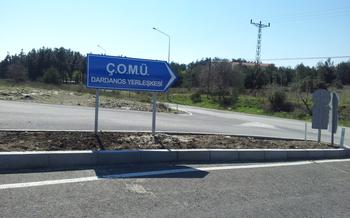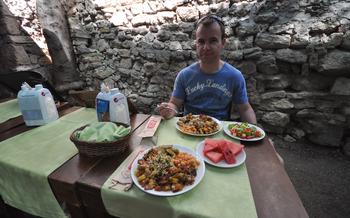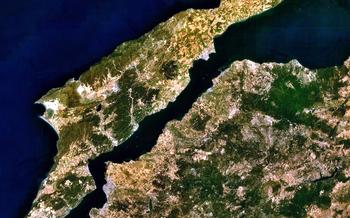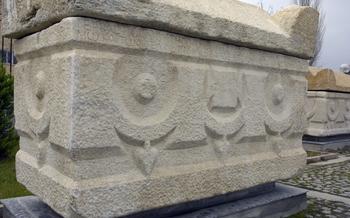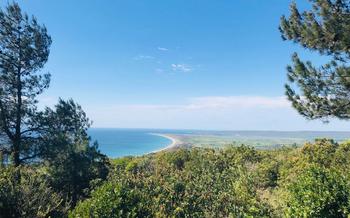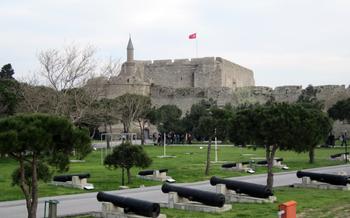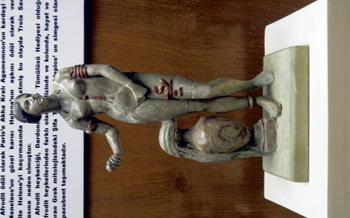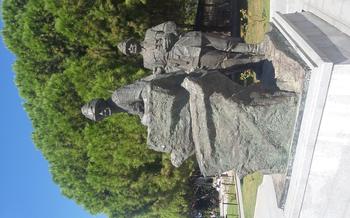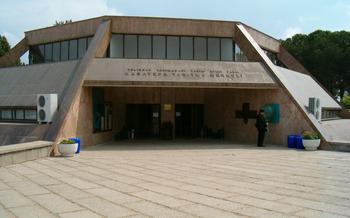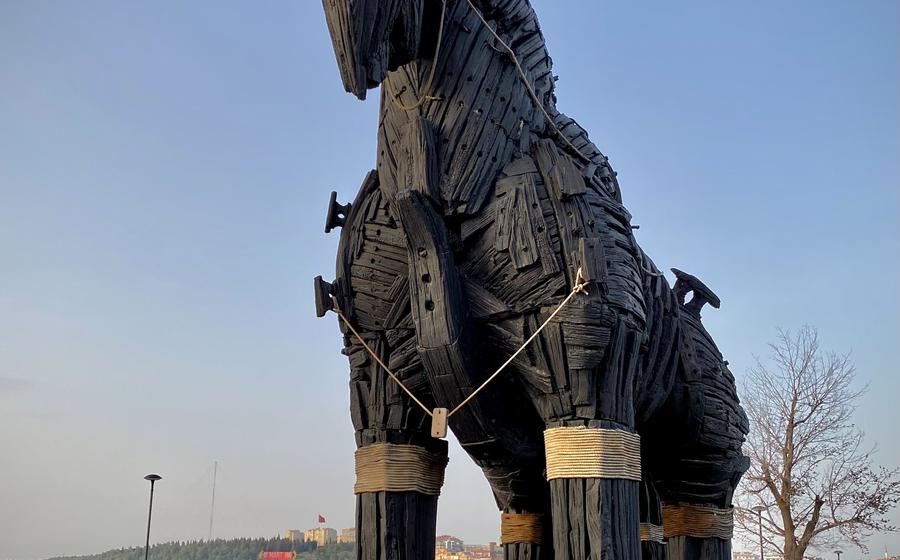
The Trojan Horse
- Historical Significance: Journey Through the Legends of Troy
- Location and Accessibility
- The Trojan Horse Replica
- Troy Museum: A Treasure Trove of Ancient Discoveries
- Archaeological Excavations
- City Walls and Gates
- Temple of Athena
- Houses and Streets
- Theater and Odeon
- Byzantine and Ottoman Remains
- Panoramic Views
- Guided Tours: Unveiling the Secrets of Troy with Expert Insights
- Souvenirs and Local Products:
- Local Cuisine
- Insider Tip: Unveiling Troy's Secrets in Tranquility
Historical Significance: Journey Through the Legends of Troy
In the heart of ancient Anatolia lies the legendary city of Troy, immortalized in Homer's epic tales of the Trojan War. As you step through the gates of this historical marvel, you'll embark on a journey through time, uncovering the secrets of a civilization that once thrived on the banks of the Scamander River.
Explore the archaeological excavations that have brought to light the ruins of Troy, revealing remnants of its walls, temples, and houses. Discover artifacts that tell the story of a city that witnessed the clash of civilizations and the birth of legends.
Immerse yourself in the myth of the Trojan Horse, a tale of cunning and betrayal that led to the fall of Troy. Let your imagination run wild as you picture the wooden horse wheeled into the city, sealing its fate.
At the ancient city of Troy, history and myth intertwine, inviting you to experience the grandeur and tragedy of a civilization that has captivated the world for centuries.
Location and Accessibility
Çanakkale, a charming city nestled in northwestern Turkey, serves as the gateway to the legendary ancient city of Troy. To embark on this historical journey, you can conveniently reach Troy either by car, bus, or by opting for an informative guided tour from Istanbul, a vibrant metropolis brimming with its own historical treasures.
If you choose to drive, the scenic route along the Dardanelles Strait offers breathtaking views of the turquoise waters and lush landscapes. Simply follow the signs towards Çanakkale, and within a comfortable 4-5 hour drive, you'll find yourself at the doorstep of ancient Troy.
Alternatively, if you prefer a more relaxed mode of transportation, several bus companies operate regular services from Istanbul to Çanakkale. These buses provide a comfortable and affordable option, taking approximately 6-7 hours to complete the journey.
Guided tours, led by knowledgeable experts, offer a comprehensive and immersive experience of Troy. These tours typically depart from Istanbul early in the morning, allowing ample time to explore the ancient city, visit the Troy Museum, and delve into the captivating tales of the Trojan War.
Troy's proximity to other historical sites, such as Gallipoli and Assos, further enhances its appeal. Gallipoli, renowned for its poignant World War I battlefields, is a mere 1-hour drive away, while Assos, with its ancient ruins and stunning coastal views, is approximately 2 hours away. This proximity allows you to combine your visit to Troy with exploration of these neighboring historical gems.
Regardless of your preferred mode of transportation, reaching Troy is a breeze, ensuring a seamless and enjoyable journey to this iconic site.
The Trojan Horse Replica
At the entrance of the ancient city of Troy, an impressive replica of the legendary Trojan Horse stands tall, serving as a symbol of the epic tale that unfolded here. This iconic sculpture, towering over visitors, evokes a sense of awe and intrigue.
The Trojan Horse holds a significant place in Greek mythology, cunningly devised by the Greeks to infiltrate the fortified city of Troy. According to legend, the Greeks constructed a gigantic wooden horse and left it as an offering to the goddess Athena, tricking the Trojans into believing it was a peace offering. Once inside the city walls, Greek soldiers hidden within the horse emerged, leading to the fall of Troy.
Standing close to this replica, one can't help but be captivated by its sheer size and imposing presence. Constructed with meticulous attention to detail, it accurately depicts the horse from ancient accounts, complete with a hollow interior and a hidden entrance. Visitors can climb inside the replica, experiencing firsthand the claustrophobic conditions faced by the Greek soldiers who concealed themselves within.
The replica of the Trojan Horse serves as a powerful reminder of the ingenuity and strategy employed in ancient warfare. It's an iconic symbol that brings the legendary tale of Troy to life, inviting visitors to immerse themselves in the captivating history that surrounds this ancient city.
Troy Museum: A Treasure Trove of Ancient Discoveries
The Troy Museum stands as a testament to the rich history and cultural heritage of the ancient city. This modern and well-curated museum houses an extensive collection of archaeological findings that provide a glimpse into the daily life, culture, and art of the ancient Trojans.
Among the museum's highlights are a vast array of pottery, intricately crafted jewelry, tools that offer insights into the technological advancements of the time, and sculptures that showcase the artistic prowess of the Trojans. These artifacts paint a vivid picture of the vibrant civilization that once thrived within the city walls.
Take your time to explore the museum's galleries, each dedicated to a specific aspect of Troy's history. Learn about the city's founding, its rise to prominence, and its eventual fall. Discover the stories behind the artifacts, and gain a deeper understanding of the people who called Troy their home.
The Troy Museum is a must-visit for anyone interested in ancient history and archaeology. Its collection provides a tangible connection to the past, allowing visitors to step back in time and experience the grandeur of this legendary city.
Archaeological Excavations
Ongoing archaeological excavations at the site of ancient Troy, led by teams of international experts, play a vital role in uncovering new evidence and shedding light on the city's history. These excavations have revealed fascinating insights into the city's layout, architecture, and daily life. Visitors to Troy have the opportunity to witness these excavations firsthand and gain a deeper understanding of the site's rich past.
The excavations have uncovered numerous artifacts, including pottery, tools, weapons, and jewelry, which provide valuable clues about the city's inhabitants and their way of life. These findings have helped archaeologists piece together the history of Troy and its role in the ancient world.
One of the most significant discoveries was the uncovering of the city's massive fortifications, which included towering walls and impressive gates. These fortifications played a crucial role in the city's defense during the legendary Trojan War.
Visitors to Troy can join guided tours that provide exclusive access to the excavation sites and offer insights from the archaeologists themselves. These tours offer a unique opportunity to learn about the latest findings and gain a deeper appreciation for the ongoing research that is shaping our understanding of this iconic city.
City Walls and Gates
The ancient city of Troy was once a formidable fortress, protected by sturdy walls and imposing gates. Explore the remains of these fortifications, which once stood as a testament to the city's strength and resilience. Marvel at the intricate construction techniques and materials used to build these defensive structures. Walk along the remnants of the city walls, imagining the fierce battles that took place here during the legendary Trojan War.
Descend to the Scaean Gate, a monumental entrance that played a pivotal role in the fall of Troy. According to Greek mythology, the Trojan Horse, a cunning stratagem devised by the Greeks, was brought into the city through this very gate, leading to Troy's ultimate demise. As you stand before the ruins of this iconic gate, let your imagination transport you back in time to witness the dramatic events that unfolded here.
Temple of Athena
Within the ancient city of Troy lies the Temple of Athena, a significant religious site that once held great importance in Trojan society. Dedicated to the goddess Athena, revered for her wisdom and warfare prowess, the temple stands as a testament to the deep-rooted spiritual beliefs of the Trojans.
The architectural features of the Temple of Athena showcase the skill and artistry of the ancient builders. Constructed using large stone blocks, the temple's imposing structure and intricate carvings exude an aura of grandeur. The temple's design incorporates a cella, or inner chamber, where a cult statue of Athena would have been placed, symbolizing her divine presence.
The Temple of Athena served as a central location for religious rituals, ceremonies, and offerings to the goddess. Devotees would gather within its sacred walls to seek guidance, protection, and victory in battle. The temple's significance extended beyond religious practices, as it also played a crucial role in shaping the cultural and social fabric of ancient Troy.
Exploring the ruins of the Temple of Athena offers visitors a glimpse into the spiritual beliefs and practices of the ancient Trojans. While time and natural elements have eroded much of the temple's original structure, its enduring presence evokes a sense of awe and reverence for the religious devotion that once permeated this ancient city.
Houses and Streets
Within the ancient city of Troy, the remnants of houses and streets offer a glimpse into the daily life of its inhabitants. These structures, built using local materials such as stone, mud-brick, and wood, provide insights into the city's urban layout and organization. The houses, varying in size and design, showcase different architectural styles and reflect the social hierarchy of ancient Troy.
Explore the narrow, winding streets that once bustled with activity, lined with shops, workshops, and public spaces. The well-preserved ruins of these structures allow visitors to imagine the vibrant atmosphere of Troy's bustling marketplace, where traders from across the region gathered to exchange goods and ideas.
Pay attention to the intricate details of the houses, such as the stone foundations, plastered walls, and wooden beams. Notice the remnants of hearths and ovens, suggesting the domestic activities that took place within these homes. Discover the water cisterns and drainage systems that provided essential services to the city's residents.
As you wander through the ruins of Troy's houses and streets, let your imagination transport you back in time to experience the sights, sounds, and smells of this ancient city. Picture the inhabitants going about their daily lives, engaging in conversations, conducting business, and raising their families within these walls.
Theater and Odeon
Amidst the ruins of ancient Troy, two captivating structures stand as testaments to the city's vibrant cultural life: the theater and the odeon. These venues served as platforms for entertainment, performances, and social gatherings, adding a rich dimension to Trojan society.
The theater, with its impressive seating arrangements and carefully designed acoustics, hosted dramatic performances, musical concerts, and other spectacles. Imagine the atmosphere as thespians brought ancient Greek myths and legends to life, captivating audiences with their artistry and eloquence.
The odeon, a smaller yet equally significant venue, was dedicated to more intimate performances and recitals. Poetry readings, musical recitals, and chamber music concerts filled the air with melodies and harmonies, creating an enchanting ambiance within the ancient city.
Exploring these performance venues transports visitors back in time, allowing them to envision the vibrant cultural tapestry of ancient Troy. Whether attending a reenactment of a classic Greek play or simply marveling at the architectural ingenuity, the theater and odeon offer a glimpse into the sophisticated and multifaceted nature of Trojan society.
Byzantine and Ottoman Remains
As you explore the ancient city of Troy, you will encounter remnants of Byzantine and Ottoman settlements that have left their mark on the site's history. Discover the ruins of Byzantine churches, adorned with intricate mosaics and architectural details, which tell the story of early Christianity in the region. Explore Ottoman fortifications, including towers and walls, that once protected the city during the Ottoman Empire. These remains stand as testaments to the diverse cultural influences that have shaped Troy throughout the centuries, adding layers of complexity to its rich historical tapestry.
Panoramic Views
As you ascend to the highest point of the ancient city of Troy, a breathtaking panorama unfolds before your eyes. The Aegean Sea stretches out to the west, its azure waters glistening under the sun. To the east, the Dardanelles Strait, a narrow waterway of strategic importance, connects the Aegean Sea to the Sea of Marmara. The Turkish countryside, with its rolling hills, lush valleys, and scattered villages, completes the stunning vista.
This vantage point offers a unique perspective on Troy's strategic location. Perched on a hill overlooking the Dardanelles, the city controlled access to the waterway, making it a crucial point of defense and trade. The panoramic views from the ancient city's highest point help you understand why Troy was such a coveted prize throughout history.
Take a moment to soak in the beauty of the surrounding landscape and imagine the bustling activity that once took place here. As you gaze out over the Aegean Sea, picture ancient Greek ships sailing towards Troy, their sails billowing in the wind. Look towards the Dardanelles Strait, and envision fierce naval battles between rival empires vying for control of this strategic passage.
The panoramic views from the ancient city of Troy offer a glimpse into the rich history and significance of this iconic site. Whether you're a history buff, a nature lover, or simply someone who appreciates breathtaking vistas, the views from the top of Troy are an unforgettable experience.
Guided Tours: Unveiling the Secrets of Troy with Expert Insights
To fully immerse yourself in the rich history and significance of Troy, consider booking a guided tour. Knowledgeable guides bring the ancient city to life, providing historical context, insights into archaeological discoveries, and captivating stories that enhance your visit. Choose from group tours,เหมาะสำหรับผู้ที่ต้องการพบปะผู้คนใหม่ๆ และแบ่งปันประสบการณ์ หรือทัวร์ส่วนตัวเหมาะสำหรับผู้ที่ต้องการการเอาใจใส่เป็นพิเศษและความยืดหยุ่น
My personal experience with a guided tour at Troy was truly remarkable. Our guide, a passionate archaeologist, shared fascinating details about the excavations, the myths and legends surrounding the city, and the ongoing research that continues to shed light on its past. With their expertise, I gained a deeper understanding and appreciation for the significance of this iconic site.
Whether you are a history buff, a mythology enthusiast, or simply someone who enjoys exploring ancient ruins, booking a guided tour at Troy is highly recommended. It's an investment that will enrich your visit and leave you with lasting memories of this extraordinary place.
Souvenirs and Local Products:
Exploring the local shops and markets in Çanakkale offers a delightful opportunity to discover unique souvenirs and local products that capture the essence of the region's rich history and culture. From intricate handmade crafts and traditional Turkish delights to aromatic olive oil products, there's a wide variety of items to choose from.
In the bustling markets, you'll find an array of colorful stalls displaying an assortment of handmade goods. Admire the delicate pottery, intricately woven textiles, and exquisite jewelry crafted by local artisans. These unique pieces make for meaningful souvenirs that will remind you of your journey to Çanakkale.
Don't miss the opportunity to indulge in the famous Turkish delights, known for their sweet and delectable flavors. Baklava, with its layers of filo pastry filled with nuts and honey, is a must-try. Lokum, also known as Turkish delight, comes in various flavors and colors, offering a burst of sweetness in every bite.
For those who appreciate culinary delights, Çanakkale's olive oil products are a must-have. The region is renowned for its high-quality olive oil, produced from locally grown olives. Bring home a bottle of this liquid gold to enhance your cooking and savor the distinct flavors of the Turkish countryside.
To ensure an authentic shopping experience, visit the local shops and markets in Çanakkale. The friendly vendors are always ready to assist you and share their knowledge about the products. Whether you're looking for unique souvenirs or local delicacies, Çanakkale offers an abundance of treasures to take home and cherish.
Local Cuisine
Çanakkale's cuisine is a delightful blend of fresh seafood, traditional Turkish dishes, and regional specialties, offering a culinary journey like no other. Indulge in the succulent grilled fish, a staple of the region, prepared with expertise and infused with the flavors of the Aegean Sea. Mezes, an array of small dishes and appetizers, are a must-try, offering a tantalizing variety of flavors and textures. Savor the rich taste of Turkish coffee, a beloved beverage deeply rooted in the country's culture.
For an authentic dining experience, venture into the local restaurants and eateries. Ask for recommendations from your hotel concierge or tour guide to discover hidden gems frequented by locals. Don't miss the opportunity to sample traditional Turkish dishes such as kebabs, börek (savory pastries), and güveç (clay pot dishes). Each dish is a testament to the culinary heritage of the region, showcasing the freshest ingredients and skillful preparation.
As you savor the local cuisine, engage with the friendly locals and learn about their culinary traditions. Discover the stories behind the dishes and the passion that goes into creating each meal. Whether you're enjoying a leisurely breakfast by the sea or indulging in a traditional Turkish dinner, Çanakkale's cuisine promises a memorable and delicious experience.
Insider Tip: Unveiling Troy's Secrets in Tranquility
To fully immerse yourself in the ancient wonders of Troy, embrace the tranquility of early mornings or late afternoons. By arriving before the throngs of visitors descend, you'll have the unique opportunity to connect with the site's profound history and significance without distractions. Stroll through the ruins, marvel at the Trojan Horse replica, and let your imagination soar as you envision the legendary battles and characters that once graced this land. Remember to equip yourself with comfortable shoes for traversing uneven terrain, sunscreen to shield your skin from the Mediterranean sun, and a hat to keep cool. Dedicate ample time to explore Troy's wonders; half a day or more is recommended to fully unravel its captivating stories and secrets.
